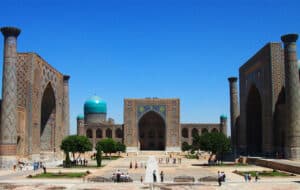Table Of Contents
Shah-i-Zinda Necropolis Travel Guide
1. Introduction
Shah-i-Zinda translates to “Living King,” a name rooted in the legend of Kusam ibn Abbas, a cousin of the Prophet Muhammad, who is believed to be buried here. This necropolis is one of the oldest and most sacred sites in Samarkand, featuring a cluster of mausoleums, tombs, and religious structures that date from the 11th to the 19th centuries. Its striking tilework—renowned for its intricate patterns and vibrant turquoise hues—has earned Shah-i-Zinda the reputation as the “jewel box” of Central Asian Islamic architecture.
Historical Quote
“There are gates to Heaven; their guardians are azure and gold.”
—A 14th-century traveler’s poetic description upon witnessing Shah-i-Zinda’s radiant entry portal.
2. A Glimpse into Its Past
The Legend of the Living King
- Kusam ibn Abbas Legend: Local lore holds that Kusam ibn Abbas, said to have brought Islam to the region in the 7th century, was martyred here but vanished into an eternal subterranean realm—hence “the living king.” Pilgrims have visited the site for centuries, seeking blessings and spiritual connection.
Timurid Influence
- Peak Construction (14th–15th Centuries): Under the Timurid Dynasty, Samarkand became a center of architectural innovation. Members of the royal family and influential nobles built sumptuous mausoleums near Kusam ibn Abbas’s shrine, resulting in a multi-era complex that showcases evolving tilework styles.
- Melding Styles: Persian, local Central Asian, and Timurid artistic traditions blended to create exquisite calligraphic panels, geometric mosaics, and elegant floral motifs.
Intriguing Facts
- Multiple Resting Places: It’s believed that more than 20 royal and noble figures are interred here, each with a uniquely designed mausoleum.
- Women Patronesses: Some of the most lavish tombs were commissioned by influential Timurid women, such as Shirin Bika Aga and Tugli Tekin, reflecting the prominence of royal women in Samarkand’s cultural life.
- Ongoing Restoration: Centuries of earthquakes and climate have caused damage; modern conservators are painstakingly recreating missing tiles using traditional techniques.
3. Architectural Highlights
The Portal Entrance
- Grand Entrance Arch: Features delicate muqarnas (stalactite-like designs) and vibrant turquoise mosaics—your introduction to the stunning artistry inside.
- Inscribed Calligraphy: Passages from the Quran and praises to the prophet line the arch, symbolizing the necropolis’s revered status.
The Narrow Passage “Street of Tombs”
- Enclosed Path: This narrow walkway lined with mausoleums is the site’s most iconic view. Each tomb boasts distinct designs that date from different periods.
- Glazed Tile Techniques: Notice how earlier mausoleums have simpler patterns, while the 14th–15th-century structures showcase more advanced polychrome tiles and carved terracotta.
Notable Mausoleums
- Shadi Mulk Aga & Shirin Bika Aga
- Commissioned by royal Timurid women, these mausoleums boast intricate floral motifs and richly woven inscriptions—a testament to the era’s finest craftsmanship.
- Tugli Tekin Mausoleum
- Renowned for its exuberant geometrical patterns. Step closer to appreciate the interplay of color under varying light conditions.
- Kusam ibn Abbas Shrine
- The spiritual heart of the complex. Many locals visit to offer prayers; photography is permitted outside, but show respect within sacred confines.
4. Photography Tips: Timing & Composition
Shah-i-Zinda is a photographer’s paradise, brimming with brilliant tiles, narrow corridors, and historic charm. Here’s how to make the most of your visit:
4.1 When to Shoot
- Morning Magic (8:00–10:00 AM):
- Soft sunlight highlights the vibrant tiles without harsh shadows. Fewer visitors mean you can capture the mausoleums without crowds.
- Late Afternoon / Golden Hour (4:00–7:00 PM, season-dependent):
- Warm, low-angle light intensifies the blue-green hues of the domes and facades, creating a dramatic contrast against the sky. Perfect for capturing the necropolis “glow.”
4.2 Angles & Approaches
- Street of Tombs Perspective
- Leading Lines: Position yourself at one end of the walkway to highlight the parallel lines of mausoleums converging in the distance.
- Symmetry vs. Asymmetry: While the path itself is linear, each mausoleum has unique features—experiment with both centered shots and creative angles.
- Close-Ups & Tile Details
- Zoom in: The mosaic patterns reward macro photography; each tile set can form mesmerizing geometric or floral shapes.
- Spot Light & Shadow: Use side lighting to accentuate raised terracotta carvings.
- Reflections & Doors
- Reflective Surfaces: Marble flooring or puddles from recent rain can mirror the mausoleums, adding depth to your shots.
- Doorway Frames: Step into a mausoleum doorway and shoot outward toward the courtyard for a framed effect.
4.3 Practical Tips
- Avoid Midday Glare: The direct overhead sun can wash out tile colors. If midday is your only option, look for shaded areas or use a polarizing filter.
- Tripods & Monopods: Generally allowed in outdoor areas, but be mindful of busy walkways—avoid blocking foot traffic.
- Respectful Photography: If you photograph worshippers or local visitors, request permission and maintain a polite distance.
5. Visiting Logistics
Opening Hours & Tickets
- Hours: Usually 8:00 AM–7:00 PM (may vary by season or restoration work).
- Entry Fee: Around 25,000–40,000 UZS for international visitors; discounts may apply for students or local residents.
- Ticket Booth: Located near the main entrance; keep your ticket handy for re-entry if you plan to return for different lighting conditions.
Getting There
- By Taxi: Easy to hail from central Samarkand (e.g., near Registan). The ride takes ~10–15 minutes.
- By Foot: If you’re staying around Bibi-Khanym Mosque or the central area, Shah-i-Zinda can be reached with a leisurely 15–20 minute walk (though be mindful of summer heat).
- Public Transport: Some city buses pass nearby, but schedules can be irregular. A taxi is often faster and inexpensive.
6. Cultural & General Tips
- Dress Modestly: Out of respect, consider covering shoulders and knees, especially if you enter any shrine area.
- Be Mindful of Worshippers: Locals may come here for prayer or contemplation. Keep your voice down and give them space.
- Stay Hydrated: Uzbek summers get hot, and shade is limited. Bring water, especially if you plan an extended shoot.
- Approach Guides or Locals: Knowledgeable guides or locals can offer insights into lesser-known mausoleums or share captivating anecdotes.
- Explore Hidden Corners: Some mausoleums off the main path are equally photogenic, with fewer visitors.
7. Nearby Attractions
- Bibi-Khanym Mosque: Just west of the necropolis, known for its monumental size and historical significance.
- Registan Ensemble: Samarkand’s most iconic square, featuring the Ulugh Beg, Sher-Dor, and Tilya-Kori madrasahs.
- Gur-e-Amir Mausoleum: The final resting place of Timur, showcasing a stunning azure dome and intricate interior.
- Siab Bazaar: A bustling local market where you can sample fresh fruits, breads, and sweets—ideal for street photography and cultural immersion.
8. Conclusion
Shah-i-Zinda captivates visitors with its layered architectural legacy and spellbinding tilework, offering a portal into the spiritual heart of Samarkand. From the narrow “Street of Tombs” to the legend of Kusam ibn Abbas, every mausoleum holds a story etched in blue and gold.
Echo of Eternity
“They say the Living King dwells here still—perhaps in the mosaic brilliance or in the hushed whispers of pilgrims who come seeking his blessing.”
– An 18th-century chronicler referencing the necropolis’s spiritual allure
As you wander through the necropolis, let the artistry of centuries guide your lens—whether you’re capturing a wide shot of kaleidoscopic domes or zooming in on the interplay of light and color on ancient walls. A visit to Shah-i-Zinda is a journey through art, faith, and history, merging to create an unmissable photography and cultural experience in Samarkand.
Related Tours




